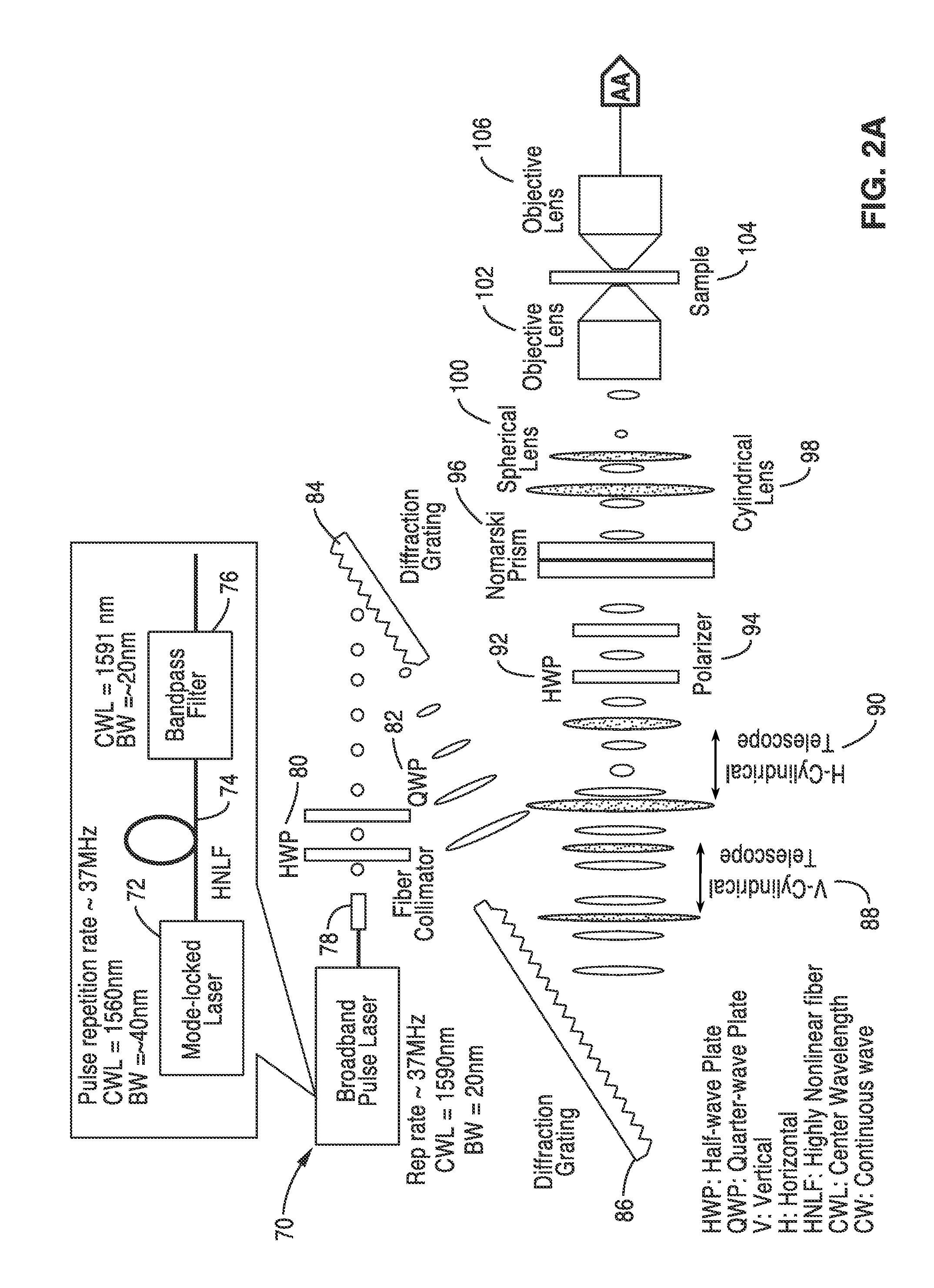Differential interference contrast serial time encoded amplified microscopy
a technology of contrast and serial time, applied in the field of optical imaging devices and methods, can solve the problems of constructive/deconstructive interference of wavelength components, and achieve the effect of revolutionizing blood analysis
- Summary
- Abstract
- Description
- Claims
- Application Information
AI Technical Summary
Benefits of technology
Problems solved by technology
Method used
Image
Examples
example 1
[0058]In order to prove the concepts of the invention, a computer model was created for the system described schematically in FIG. 2A and FIG. 2B that used a crenated sample with a 30 μm width to test the system. The model specimen was meant as a crude example of a typical application such as identification of a certain type of diseased cells. In this simulation, the resolution is assumed to be 0.5 micron and the two adjacent points are 0.2 μm apart. These are typical numbers for a conventional DIC microscope.
[0059]The model of FIG. 2A and FIG. 2B was used and a broadband pulse laser was adopted to generate the probe beam. The beam was mapped into space using a spatial-disperser such as diffraction grating or prism. The spatially-dispersed beam was split into two beams with orthogonal polarization states using a Nomarski / Wollaston prism. The two beams were focused on the sample such that every two adjacent points were illuminated by a certain wavelength but with two different polari...
example 2
[0065]In order to illustrate the methods for fabrication and the functionality of the differential interference contrast serial time encoded amplified microscopy system, an imager apparatus was constructed according the general schematic shown in FIG. 1. Both one dimensional and two dimensional images of a sample were obtained. The second dimension of the images was obtained by translating the sample in the direction orthogonal to that of the line scans. The sample was a transparent material with periodically refractive-index modulation (i.e. a transmission grating with groove density of ˜70 lines / mm).
[0066]The optical source was a mode-locked laser with a center wavelength of 1560 nm and a pulse repetition rate of 36.1 MHz. A highly nonlinear fiber and optical band-pass filter following the laser produced a train of pulses with ˜20 nm bandwidth centered at 1591 nm was used as an illumination beam.
[0067]Using a pair of diffraction gratings with 1100 lines / mm groove density, the puls...
example 3
[0070]In order to further demonstrate the functionality of the methods and imager, the apparatus shown in FIG. 1 was constructed and used for high-speed, high-contrast imaging of fast-flowing unstained white blood cells. White blood cells were isolated from whole blood by hypotonic lysis of red blood cells and re-suspended in phosphate buffered saline.
[0071]The optical source that was used was a mode-locked laser with a center wavelength of 1560 nm and a pulse repetition rate of 36.1 MHz. A highly nonlinear fiber and optical band-pass filter following the laser produces a train of pulses with ˜20 nm bandwidth centered at 1591 nm as an illumination beam. Using a pair of diffraction gratings with 1100 lines / mm groove density, the pulses were spatially-dispersed into a 1D rainbow pattern enabling 1D line-scanning of the object. The 1D spatially-dispersed (i.e., 1D rainbow) were sent to a half-wave plate and a polarizer to rotate the polarization state of the light and to ensure a 45-de...
PUM
 Login to View More
Login to View More Abstract
Description
Claims
Application Information
 Login to View More
Login to View More - R&D
- Intellectual Property
- Life Sciences
- Materials
- Tech Scout
- Unparalleled Data Quality
- Higher Quality Content
- 60% Fewer Hallucinations
Browse by: Latest US Patents, China's latest patents, Technical Efficacy Thesaurus, Application Domain, Technology Topic, Popular Technical Reports.
© 2025 PatSnap. All rights reserved.Legal|Privacy policy|Modern Slavery Act Transparency Statement|Sitemap|About US| Contact US: help@patsnap.com



